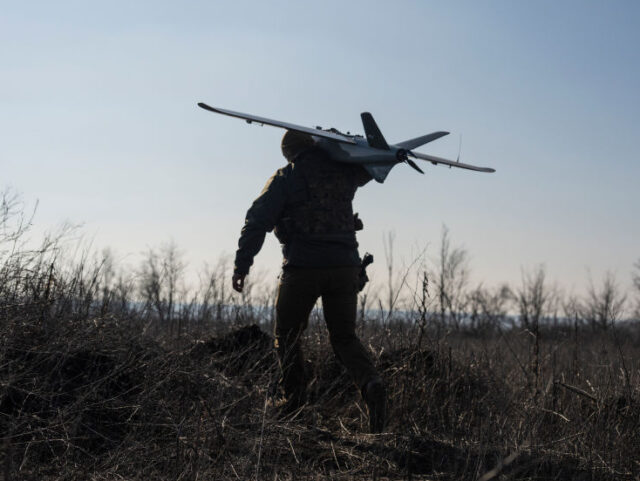Ukraine used Cessna-sized drones to attack deep inside the Russian Federation in the early hours of Tuesday morning, launching multiple strikes against a factory and oil refinery in the longest range hits of the war so far.
A drone factory and an oil refinery over 800 miles from the frontline of Russia’s invasion of Ukraine were the targets in an attack claimed by Kyiv’s military intelligence bureau in the early hours of Tuesday morning. Footage shared from the scene by Ukrainian state media shows a large drone — perhaps the size of a civilian single-engine pleasure aircraft — crashing into a building in a residential area and exploding.
‘Massive Blaze’ After Ukraine Drone Attack on Oil Depot Inside Russia https://t.co/UrTMlHvKLG
— Breitbart London (@BreitbartLondon) January 19, 2024
The drone bears a strong superficial resemblance to the products of Ukrainian drone manufacturer AeroDrone who produced autonomous crop-dusters before the war but switched to military applications after Russia’s invasion. Their Enterprise model boasts a 3,100 km range (1,900 miles) and can carry a 300kg payload (660 lbs). The Ukrainian government signed a deal with the company to deliver drones to the Ministry of Defence this time last year.
As is typical for the war Ukrainian and Russian sources have differing accounts on the strike, which is the longest-range by Ukrainian forces of the war so far, hitting targets inside the Tatarstan region on the Volga, previously untouched by the conflict. Todays’ is not the first long-range strike, however, with previous attempts made to hit Moscow itself
Russia decried the strike as a terrorist attack but said it was ineffective and didn’t interrupt industrial production in the area, while Ukrainian intelligence said the hit was an effective move against the Russian economy. Russian government spokesman Dmitry Peskov called the Ukrainian strikes a terrorist act on Tuesday and appeared to vow revenge, saying the armed forces are “working to minimize this threat and eradicate it completely in the future”.
The Main Intelligence Directorate (HUR) of the Ukrainian Ministry of Defence said of the strikes they said were their own that the attack was against a “factory for the assembly of Shahed kamikaze drones” in Yelabuga, Tatarstan 1,300km (800 miles) from the border. The Shahed design originates in Iran and has proven a low cost and effective way for the Russian armed forces to launch saturation attacks against Ukrainian cities. While the drones are slow and comparatively easy to shoot down, they also cost a fraction of conventional cruise or ballistic missiles.
Russia rejected the idea Ukraine had hit their industrial capabilities, saying instead the attack only hit an accommodation block for local students, injuring 12, including young people. The Kremlin said the drones were “outfitted with NATO equipment”.
Another target was an oil refinery in Nizhnekamsk, Tatarstan. Ukrainian intelligence claimed it is one of the largest in Russia, accounting for 2.6 per cent of the nation’s whole refining capability. They said, per Ukrainian state media: “We continue to work systematically to ensure that Russia has less and less opportunities to finance the war of aggression against Ukraine. We will continue to cut off oxygen to the ‘gas station’ country in order to minimize the flow of petrodollars to the Russian war budget”.
Ukraine says the strike started a fire. Russia counter-claimed that attack failed and that the drone was disabled by a jammer.
While Ukraine remains determined to sabotage Russia’s economy to erode Moscow’s ability to continue its invasion of their national territory, many of Ukraine’s Western supporters are very reluctant to allow the conflict to escalate and become a total war. Much military equipment supplied to Kyiv by NATO comes with limitations, making clear they should only be used to take back territory in Ukraine itself, and never inside Russia proper. In other cases, long-range weapons have been withheld by NATO states because of fears Ukraine could use them to strike the Kremlin itself.
In the case of today’s refinery strike, that comes just days after Ukraine was warned by the United States to stop attacking Russian oil infrastructure. While the strikes may degrade Russian capability and income on the global energy market, it also constricts global supply, causing price rises for Ukraine’s allies. Ukraine replied to the request by stating at a Security Forum event that Russian energy infrastructure is a legitimate military target for Ukraine.
Moscow Says Ukraine Drones Hit Targets Deep Inside Russia, Including Shootdown Near Capitalhttps://t.co/9bgfpXJMUx
— Breitbart London (@BreitbartLondon) March 12, 2024

COMMENTS
Please let us know if you're having issues with commenting.